Wild Leopard Geckos come from the hot and rocky desert scrubs of southwestern Asia. Reptile enthusiasts find them fun and easy to care for, especially since their native habitat is fairly simple to recreate.
A common misconception is Leopard Gecko should have sand in their habitat. This is not true. In the wild a Leopard Gecko habitat is more rocky terrain and less desert.
The most important factors when setting up a leopard gecko’s enclosure are tank temperature gradient, hides and substrate.
This guide will teach you everything you need to know about how to set up the best Leopard Gecko habitat so your Leo can live a long and healthy life!
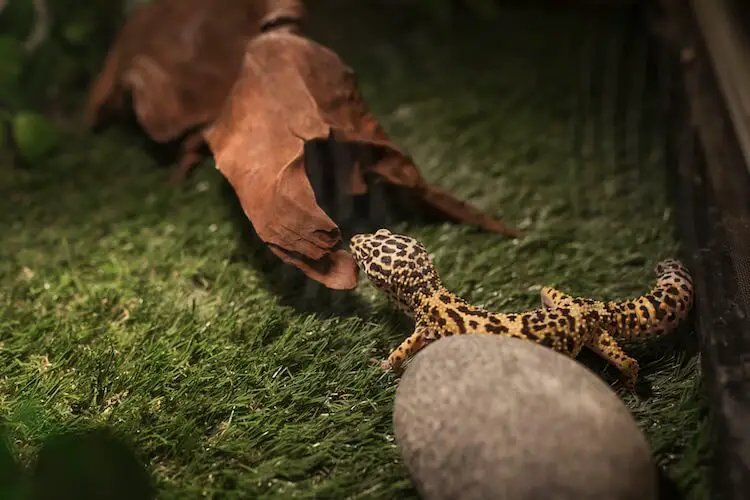
If you want to own pet reptiles, whether it’s a leopard gecko or other lizards, you need to familiarize yourself with the creature’s natural environment. Geckos, especially leopard geckos, live in semi-desert areas and the arid grasslands of places like Iran.
While you may not live where leopard geckos originate, you can simulate a gecko habitat in your own home. You may have to make a few visits to your local pet store, but it will be worth it if you want to raise pet reptiles properly.
The most important factor to consider for your leopard gecko setup is tank size.
The optimal tank size for one leopard gecko depends on its age. Baby leopard geckos aged 0 to 2 months need a tank of at least 10 gallons. In general, each adult gecko needs at least 20 gallons of space to thrive.
Anything less than a 20-gallon is generally too small to fit a food bowl, water bowl, decorations and hides.
Some owners chose to house babies in 10-gallon tanks and then purchase a larger terrarium after the first year. However, you could invest in a 20-gallon tank for your leopard gecko’s enclosure from the start just to save time and money.
Types of Leopard Gecko Tanks
There are four types of leopard gecko tanks you can house your Gecko in:
- Glass
- Wood
- Mesh
- Plastic
The best material for a terrarium is glass.
Glass Leopard Gecko enclosures are more popular and easier to find in a variety of sizes.
You can use wood if you really like the appearance. However, wood is a possible fire hazard and can be difficult for beginners to maintain humidity levels.
Glass
Glass tanks are very easy to clean and they maintain humidity levels well.
They also have transparent sides which makes it great for viewing your pet.
An advantage of glass tanks is the ability to stick thermometers, fake plants and other decorations on the glass walls.
Glass enclosures are generally lightweight so they are easy to move when cleaning or re-organizing the tank.
You can either buy a 20-gallon aquarium tank (with a matching mesh top) or a reptile tank with doors that open on the side.
The only disadvantage of a glass leopard gecko habitat is its high price. A high-quality glass tank will cost $100 to $200.
Wooden
Wooden enclosures are a good option for owners that want a beautiful leopard gecko habitat.
Unfortunately wooden enclosures are difficult to find and do not make practical Leopard Gecko habitats.
They are also not as practical when compared with glass tanks.
Wooden tanks are prone to being damaged by wear and tear from water and heat.
Finally, these habitats are difficult to clean and are prone to absorbing water. This means their habitat will need to be cleaned more frequently to prevent mold, bacteria growth, and other moisture-related issues that can impact your leopard geckos.
The price for a wooden leopard gecko tank can range from $50 to $300.
Mesh
Mesh vivariums are normally used for reptiles that enjoy climbing. Veiled chameleons are housed in mesh enclosures because they are arboreal.
Leopard Geckos are not arboreal so do not climb. Because of this they should be housed in tanks that are long and not tall.
Many mesh cages are tall as they are built for reptiles that like to climb. Because of this, it can be difficult to find a 20-gallon-long mesh tank suitable for a Leopard Gecko.
If you do manage to find a long 20-gallon mesh tank then consider humidity and stress.
Mesh sometimes prevents proper humidity retention and the visible open space might stress your Gecko.
Plastic
Plastic enclosures are the cheapest option on this list.
They will normally cost $20 to $30.
Plastic tanks are normally an eyesore and do not look as good as wooden or glass enclosures.
If you do decide to buy a plastic enclosure then make sure that it is non-toxic and PVC free.
What Size Tank Should I Get For A Leopard Gecko?
Juveniles require a 10-gallon long tank. However, it is better if you can purchase an adult enclosure from the start. Adult Leopard Geckos need at least a 20-gallon long tank. A 20-gallon tank size also provides enough space for a Gecko to roam and explore.
If you decide to buy a smaller starter tank remember juveniles grow fast. Every three months they grow an extra inch.
As soon as they measure over six inches they need a 20-gallon-long habitat.
It is not recommended to house two leopard geckos together.
Housing more than one Gecko in the same habitat can lead to injuries or death due to territorial aggression. Aggression is common in both males and females.
If you decide to house multiple Geckos together use a 30-gallon tank with multiple hides so each has their own space.
Best Leopard Gecko Enclosure
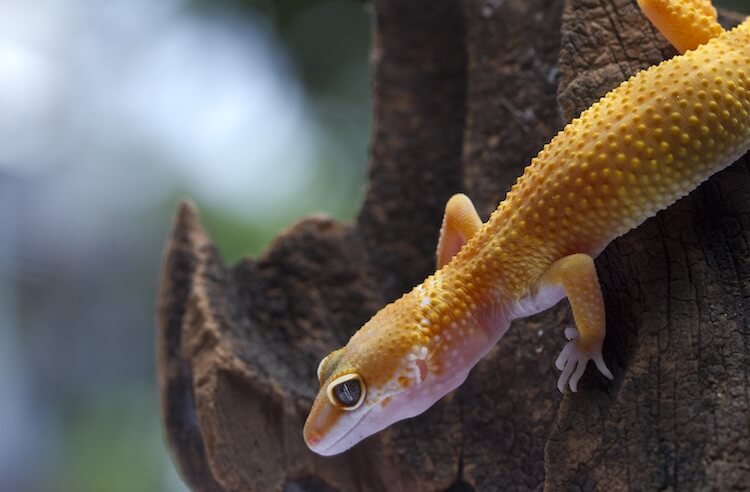
The best habitat for your Leopard Gecko is a 20-gallon-long glass tank.
Glass provides a surface for thermometers and decorations, is extremely easy to clean and move and makes observing your Gecko fun.
They can be more expensive than other tank types but glass’ functionality is far superior.
Leopard Gecko Lighting and Heating
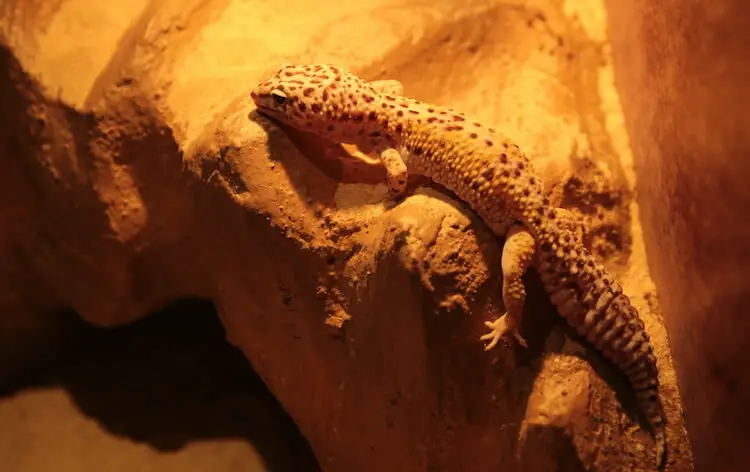
You will need to invest in a wide range of leopard gecko habitat accessories to take care of your pet reptile.
During the day your Leopard Gecko will need a heat gradient of 90°F to 75°F. The warm side of their tank should reach 90°F and not be hotter than 95°F.
In order to heat their habitat you will need to use a proper heat source. A ceramic heat emitter is the best option. Make sure you connect it to a thermostat (read thermostat not thermometer!) to control the heat.
You will need to place a 13 to 25-watt UVB bulb on the hot side of their tank. Make sure the bulb is below 6% and is only on for ten hours a day.
Although a UVB rays are not required having one can be beneficial for your Leopard Gecko. In my experience, I have seen that many Geckos seem healthier and more vibrant with a UVB light.
Make sure their UVB light is not too bright as it can damage their eyes.
By placing the bulb on one side of the tank it will form a natural heat gradient.
If you decide not to use a UVB light make sure to use a D3 supplement.
At night allow tank temperature to drop to just above 70°F.
Leopard Gecko Humidity
Unlike other tropical geckos, Leopard Geckos should have a humidity level of 30 to 40%. You will need to buy a hygrometer to monitor humidity. Stick it to the side of the tank to emulate the leopard gecko’s habitat.
Keeping humidity levels at 30% can be difficult but under 40% humidity should be easy to maintain.
If humidity levels are too low then place a small bowl of water close to the basking light.
The water level should not be higher than your Gecko’s ears as this can cause drowning.
You should also put wet sphagnum moss to create a moist hide too. When wild Leopard Geckos shed their skin a humid hide will help. You will need a cave-like hide with one enter/exit hole. Make sure that this designated hide is near the hot side of their habitat.
If you find that the humidity is too high, then move the water bowl away from your heat lamp. If still humidity remains high, make sure to check your that substrate (e.g. reptile carpet) is not retaining any water.
Leopard Gecko Substrate
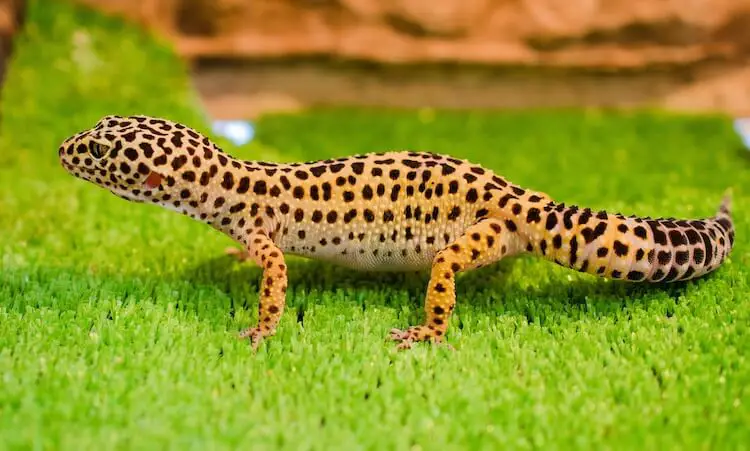
One of the most controversial and misunderstood aspects of setting up a Leopard Gecko Habitat is their substrate.
A common and dangerous misconception is that wild Leopard Geckos live on sand.
Any form of loose substrate like sand poses an impaction risk. Impaction is a blocked bowel because you reptile has eaten something it cannot digest.
It is highly recommended you do not use any type of loose substrate.
Luckily, there are countless substrates that are easy to clean, pose no risk of impaction, and perfectly simulate a leopard gecko’s natural habitat…
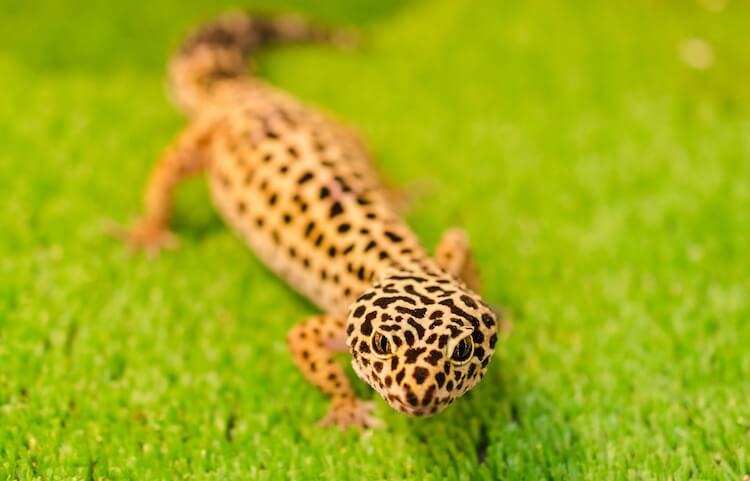
Reptile Carpets
Reptile carpet (pictured above) is an astroturf-like material that is specifically made for reptile habitats.
Many leopard gecko owners use reptile carpet because it is hardwearing, reusable and cheap.
If you buy reptile carpet then get two. You will need to wait a day for it to dry entirely after cleaning – otherwise you can accidentally increase tank humidity.
The only disadvantage of reptile carpet is the artificial loops can snag your Leopard Gecko’s claws and cause injury.
Newspaper
Newspaper is also a great substrate for Leopard Geckos. It is free and dry.
Paper towels are also a good substrate for the same reasons.
Both substrates are easy to clean and replace. The best way to keep the newspaper or paper towels clean is to spot clean daily and replace it weekly. Also, moist substrate needs to be regulated since it can lead to too much humidity.
Unfortunately, newspaper and paper towels aren’t found in the native habitat of a wild leopard gecko, which is important for owners that want themed reptile tanks.
Shelf Liner
Shelf liner is a great substrate for a Leopard Gecko’s tank.
Shelf liner is any sort of rubber matting that is used to place in kitchen cabinets.
Many people use this liner due to its low water retention and because it is easy to clean.
It is also a great option because it comes in many different patterns and designs.
Shelf liner also comes in larger rolls so you can replace it every few weeks.
Make sure to use a non-adhesive shelf liner. Sticky shelf liner is not only difficult to replace but it can have toxic chemicals in the glue.
Alfalfa Pellets
Alfalfa pellets are small food pellets fed to rabbits and other small mammals.
There are some benefits to using Alfalfa Pellets as a substrate such as it retains heat well and keeps bacteria out.
It is common to see Alfalfa Pellets being used in a Bearded Dragon tank.
Unfortunately this substrate should not be used because its small size poses a risk of impaction.
Sand
Sand is an umbrella term for substrate that covers products like reptile sand and calcium sand.
Many beginners use sand as it is sold at pet stores.
Sand is aesthetically pleasing and it seems like it would be a good idea because these Geckos come the deserts of Pakistan, Iran, Iraq and Afghanistan.
However, this substrate poses many health risks for your Leopard Gecko.
Sand should never be used for your Leopard Gecko’s habitat.
If a Leopard Gecko accidentally eats sand it can block their intestine. This leads to many health problems and potentially premature death.
Supplies, Décor and Landscaping
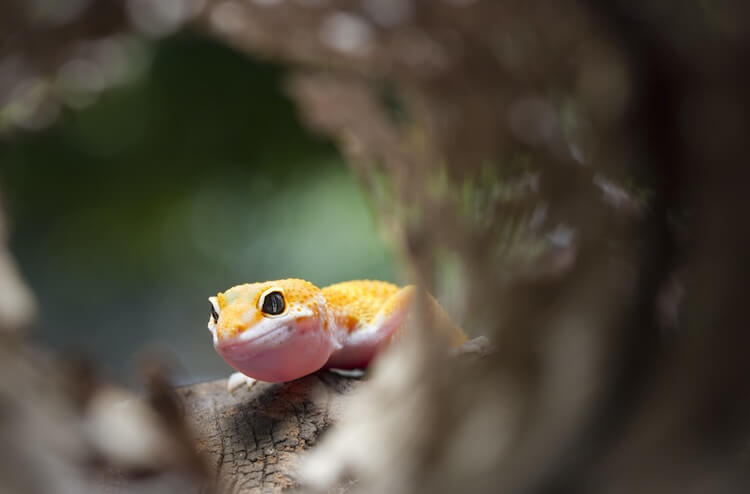
The decor and supplies you place in a Leopard Gecko’s habitat should enrich their tank and make it natural.
In the wild Leopard Geckos hide from predators in small spaces and crevices to escape from potential danger. So a good Leopard Gecko habitat should provide at least three hides:
- The first hide should be placed on the hot side of the tank.
- This second hide is a humid hide with wet sphagnum moss.
- A final hide should be placed on the cool hide.
Many owners build their own hides using Tupperware with a hole cut out. Anything that retains humidity well is a functional hide. Having more than three hides will give your Gecko many places to explore and rest.
Even though this species does not have sticky toe pads like a Gargoyle Gecko, they still love to explore.
I would encourage you to place decor that allows them to explore. My Leopard Gecko loves his reptile hammock and laying on top of a rock ledge.
Just make sure to not place any rocks or decor too high. This will help to prevent injuries from falling.
Adding fake plants and branches for your Gecko to climb on is always a good idea. It provides enrichment and adds charm to a tank. Real branches should be placed in boiling water for at least 15 minutes to ensure that they are disinfected before placing them in the tank.
Finally, you will need a water bowl in their enclosure.
Make sure that the water bowl is not too deep. It should be below ear level in order to prevent drowning.
Do Leopard Geckos Need Heat Rocks?
No, they absolutely do not heat rocks. If you set up the warm hide of your leopard gecko habitat, you do not need to provide extreme heat sources for your geckos.
In fact, heat rocks can cause skin burns to geckos, especially if they malfunction. So, if you want to keep your geckos warm in their habitat, just pay close attention to the three hides mentioned above, as well as a basking area where they can heat up when it gets too cool.
Best Leopard Gecko’s Habitat Setup
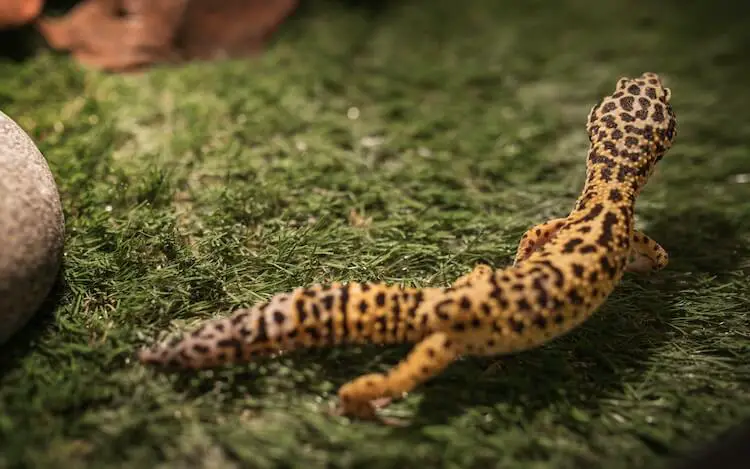
Setting up a Leopard Gecko habitat can feel daunting. Hopefully by now, you know exactly what you need for your own leopard gecko.
Below we have made a list of everything you should include to make sure your Gecko loves his tank:
- 20-gallon glass reptile terrarium.
- Non-adhesive shelf liner for substrate.
- Three hides (hot, humid and cool).
- Fake plants and branches.
- Water and food bowls.
- Ceramic heat emitter and lamp.
- 25-watt UVB bulb (no more than 6%).
- Thermostat, thermometer and hygrometer.
It is important to remember that your Leopard Gecko needs a 20-gallon long tank that is ideally made from glass.
A tank needs a heat source and the best one to use is a ceramic heat emitter. Provide a temperature gradient from 90°F to 75°F. A UVB tube light is recommended too – but this is optional. The goal is to maintain the leopard gecko body temperature of between 94 and 97°F.
Your tank will need to have humidity of 30 to 40% that should be monitored with a hygrometer.
There are multiple substrates available, but paper towels, newspaper, reptile carpet, or shelf liner all work very well. Remember to always avoid loose substrate, as it can lead to impaction.
Have you discovered anything interesting to add to your enclosure? How did you set up your Leopard Gecko’s tank? Let us know below.

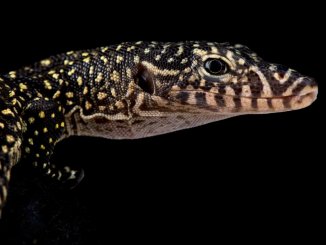
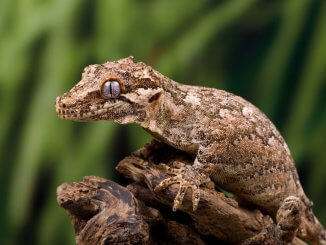
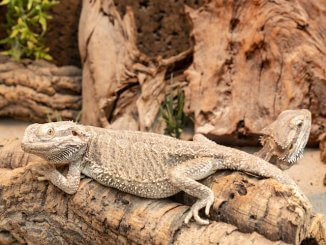

I came across a Gecko morph called Jungle Bandit – is that a recognized morph?
Yes, there is also a lavender Jungle Bandit.
Can I use the moss reptile carpet?
Hi Toto, take a look at our guide on the substrates for leopard geckos.
Hi! What wattage do you recommend for the ceramic heat emmiter? 50, 75, 100, or 150
what are some things to stir from with food
All fruits and vegetables. They might eat them, but they lack the enzymes to digest them, potentially causing serious health issues. Wild insects could be fine, but they are generally advised against, because they can carry pathogens, parasites and pesticides which would be harmful to your Gecko.
Follow our Leopard Gecko diet guide to know more about their dietary needs and preferences.